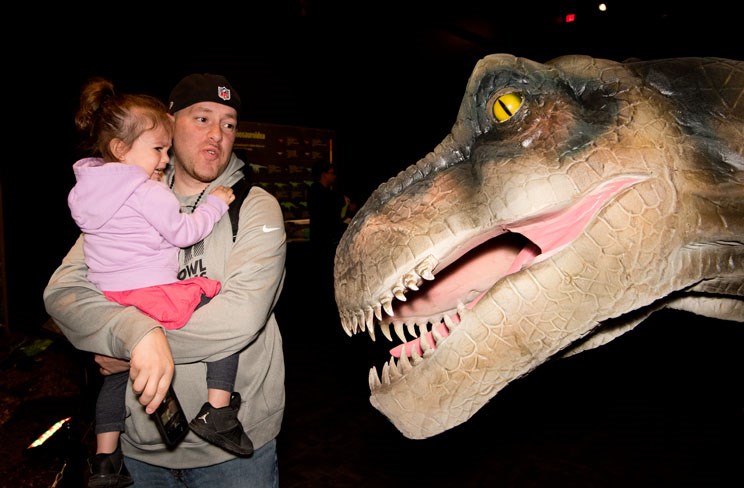Did dinosaurs have dandruff?
This feathered Microraptor did, said researcher Teresa White, as she explained a replica fossil next to a screeching animatronic of the dinosaur Thursday at Edmonton’s space and science centre. Scientists just reported this discovery a few days ago.
“There’s evidence of dandruff in the feathers,” she said, and those skin cells were shed in a way that’s closer to how humans do it than reptiles.
That’s the kind of cutting-edge research visitors can learn this week as part of the new Dinosaurs Unearthed: Down to the Bone exhibit at the Telus World of Science in Edmonton. The show, which opened Friday, uses animatronics and real and replica fossils to examine how science is changing our perception of dinosaurs.
Visitors can expect to see realistic, moving models of dinosaurs roaring, hooting, and flapping at the exhibit, including a towering two-storey tall Tyrannosaurus rex. They can also get hands-on with fossilized dinosaur poop, dig for fossils, discover their weight in dinosaurs, and check out a never-before-exhibited clutch of 34 dinosaur eggs.
Guests this Saturday can join science centre mascot Stanley the T. rex for his third birthday party, said Annie Prud’Homme-Généreux, vice-president of science at the science centre. Stanley and other area mascots (such as the A&W Root Bear) will compete in limbo and hoop tossing, and visitors can get free loot bags and cupcakes.
Evolving perceptions
There’s something about dinosaurs that really captures the imagination, said Paul Kane paleontology teacher Renee LeClerc, who hoped to take her students to see this exhibit.“The creatures are so weird and wonderful,” she said, and the students get really passionate whenever you talk about evolution or ancient Earth.
Our perceptions of dinosaurs have evolved, too, said Prud’Homme-Généreux. We used to think of them as scaly reptiles, for example, but now know that many had feathers. Up until a few years ago, we believed that the duck-billed Tsintaosaurus had a unicorn-like horn. Recent research has found that said horn was actually part of a larger crest.
“Unfortunately, we will not have unicorn dinosaurs,” she said.
Researchers have used computer models of crested dinosaur skulls (specifically Parasaurolophus) to simulate their calls, so we do know how these former unicorns may have sounded, added White, the exhibit’s curator. They also now believe that the towering T. rex was actually pretty quiet.
“If big dinosaurs like the T. rex did roar, it would be more of a chirp or a growl like an alligator,” she noted.
(The T. rexes in the show still have a room-shaking roar since that’s what the public expects, White added.)
Tyrannosaurs were actually a very successful family, having survived from the mid-Jurassic to the Cretaceous period (roughly 110 million years) and ranged in size from panthers to small buildings, White said. The oldest skeleton yet was recently discovered in Asia, suggesting that T. rex may in fact be an invasive species in North America.
Prud’Homme-Généreux said her favourite story in the exhibit was that of the Regaliceratops, which is a cousin of the Triceratops. Researchers originally dubbed this skeleton “Hellboy” due to its hellishly difficult excavation from a cliff over the Oldman River. Ten years later, after they had cleaned off the excess rock, they discovered it had two tiny horns above its eyes, much like the superhero Hellboy.
“This is Hellboy through and through,” she said.
The exhibit features examples of fossils from dinosaurs that survived brain tumours and broken bones to demonstrate the remarkable regenerative abilities of these creatures. White said researchers are now studying dinosaurs to get new ideas for modern medicine and (in the case of the thick-skulled Pachycephalosaurus) helmet design.
Dinosaurs appeal to all ages, especially when we talk about how our knowledge of them has changed over time, White said. They’re also one of the few subjects where the kids know more than their parents.
“Dinosaur knowledge is always changing, and dinosaurs are a great introduction to science.”
The exhibit runs at the Telus World of Science until November. Visit telusworldofscienceedmonton.ca for details.




